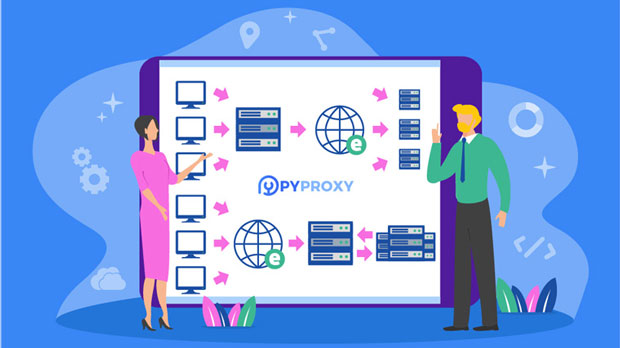How does the Socks5 proxy server work?
SOCKS5 is a popular protocol used for proxy servers that facilitates secure and flexible network communications between clients and servers. It works by acting as an intermediary layer between the user and the target server, hiding the client's IP address while forwarding requests and data. Unlike traditional HTTP proxies, which operate at the application layer, SOCKS5 functions at a lower level, making it more versatile in handling various types of network protocols, including TCP and UDP. This ability enables it to support a wide range of applications, from web browsing to gaming and torrenting. In this article, we will explore in-depth the working principle of socks5 proxies, their benefits, and how they provide enhanced privacy and security in modern digital communication. What is a socks5 proxy?A SOCKS5 proxy is a type of internet protocol that acts as a gateway between a user’s device and the internet, allowing data to be relayed through an intermediary server. Unlike other proxy types, such as HTTP or HTTPS proxies, SOCKS5 does not interfere with the type of data transmitted, making it an all-purpose solution. It can handle any type of internet traffic, whether it's web browsing, email communication, or online gaming.SOCKS5 proxies support both IPv4 and IPv6 addresses, allowing for a more comprehensive range of use cases. Additionally, they support UDP (User Datagram Protocol), which is not typically supported by traditional proxy servers. This gives SOCKS5 an edge when dealing with time-sensitive applications such as video streaming, VoIP calls, and online gaming, where low latency is critical.How Does a SOCKS5 Proxy Work?SOCKS5 operates at the transport layer of the OSI (Open Systems Interconnection) model, which means it is responsible for handling the data packets that are exchanged between the client and the server. When a user sends a request to access a particular website or service, this request is first sent to the socks5 proxy server.The proxy server acts as a relay, forwarding the request to the target server. The target server then sends its response back to the SOCKS5 server, which forwards it to the original client. Throughout this process, the user’s IP address remains hidden from the target server, as only the proxy server’s IP address is visible.The steps in this process include:1. Client Request: The user’s client (such as a browser or application) sends a request to connect to a remote server through the SOCKS5 proxy.2. Authentication: If required, the client must authenticate with the SOCKS5 server using methods like username and password.3. Request Forwarding: The proxy server forwards the client’s request to the target server.4. Data Relay: Once the target server responds, the SOCKS5 server relays this information back to the client, maintaining anonymity throughout the process.Key Features of SOCKS51. Anonymity and Privacy: One of the most significant advantages of SOCKS5 proxies is the ability to hide the user’s IP address. Since the communication between the client and the target server happens through the proxy, the actual IP address of the client remains concealed, providing an extra layer of privacy. This feature is especially useful for individuals looking to protect their identity while surfing the web or engaging in sensitive activities.2. No Data Alteration: Unlike HTTP proxies, which inspect and modify the data passing through them, SOCKS5 proxies do not alter the data packets. This feature ensures that the transmitted data is kept intact, which is beneficial for applications that require a high level of data integrity, such as file transfers or VPN usage.3. Support for UDP: SOCKS5 supports both TCP (Transmission Control Protocol) and UDP, making it suitable for a wide range of use cases. UDP is particularly advantageous for real-time applications like video streaming, VoIP, and online gaming, where low latency is critical.4. Flexible Authentication Methods: SOCKS5 allows for multiple authentication mechanisms, including username/password authentication, which ensures that only authorized users can access the proxy. This feature adds a layer of security and prevents unauthorized access to the server.5. Bypassing Geographic Restrictions: SOCKS5 proxies are commonly used to bypass geo-restrictions or censorship, enabling users to access content that may be blocked in their region. By routing traffic through a server located in a different geographic area, users can appear as though they are accessing the internet from a different location.SOCKS5 Proxy vs. Other Proxy TypesWhile SOCKS5 is often compared to other proxy types, such as HTTP and HTTPS proxies, it offers distinct advantages that make it a more versatile and robust solution for certain use cases.1. SOCKS5 vs. HTTP Proxy: The primary difference between SOCKS5 and HTTP proxies lies in the protocol they support. HTTP proxies can only handle HTTP and HTTPS traffic, meaning they are limited to web browsing. In contrast, SOCKS5 can handle a wide range of protocols, including FTP, SMTP, and POP3, making it suitable for many different types of internet activities.2. SOCKS5 vs. HTTPS Proxy: HTTPS proxies provide encrypted connections, offering a higher level of security than HTTP proxies. However, SOCKS5 proxies, while not encrypted by default, are often used in conjunction with encryption methods like SSL/TLS to secure data transmissions. Additionally, SOCKS5 is more flexible and can handle various types of traffic beyond web browsing, whereas HTTPS proxies are designed specifically for encrypted web traffic.3. SOCKS5 vs. VPN: While both SOCKS5 proxies and Virtual Private Networks (VPNs) help with privacy and security, they differ in their implementation and capabilities. A VPN encrypts all of the traffic from the user's device, securing data at the network level. SOCKS5, on the other hand, is less resource-intensive and works only at the application level, offering faster speeds for specific use cases like gaming or streaming but without the same level of encryption.Benefits of Using SOCKS5 Proxy Servers1. Enhanced Privacy: By masking the client’s IP address, SOCKS5 provides users with an extra layer of privacy, making it more difficult for websites and servers to track their online activity. This is particularly valuable for individuals concerned about surveillance or data collection.2. Unrestricted Access: SOCKS5 proxies are often used to bypass government censorship or geographic restrictions, enabling users to access websites and content that would otherwise be blocked. This makes SOCKS5 a popular tool for accessing region-locked content such as streaming services or social media platforms.3. Improved Security: Although SOCKS5 does not inherently encrypt data, it can be used in conjunction with encryption methods like SSL/TLS to secure communication. Additionally, SOCKS5’s support for UDP is beneficial for applications requiring real-time communication, ensuring low-latency connections.4. High Flexibility: SOCKS5 proxies can handle a variety of protocols, including TCP and UDP, which allows them to support different applications such as web browsing, file transfers, gaming, and more. This flexibility makes them a valuable tool for individuals and businesses alike.ConclusionIn conclusion, SOCKS5 proxies offer a powerful and versatile solution for enhancing privacy, bypassing restrictions, and securing online communications. By functioning at the transport layer and supporting various protocols, SOCKS5 provides users with more flexibility compared to other types of proxies. Although it does not provide inherent encryption, it can be paired with other security measures to protect sensitive data. As the internet becomes an increasingly important part of our daily lives, understanding the workings of SOCKS5 proxies and leveraging their capabilities can provide a significant advantage in terms of both privacy and performance. Whether for personal use or business purposes, SOCKS5 proxies remain a valuable tool in navigating the complexities of modern digital communications.
2024-12-23

























































